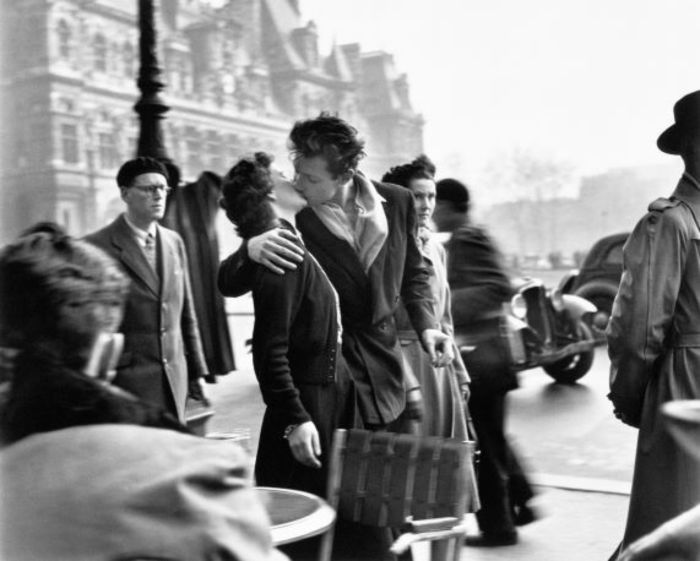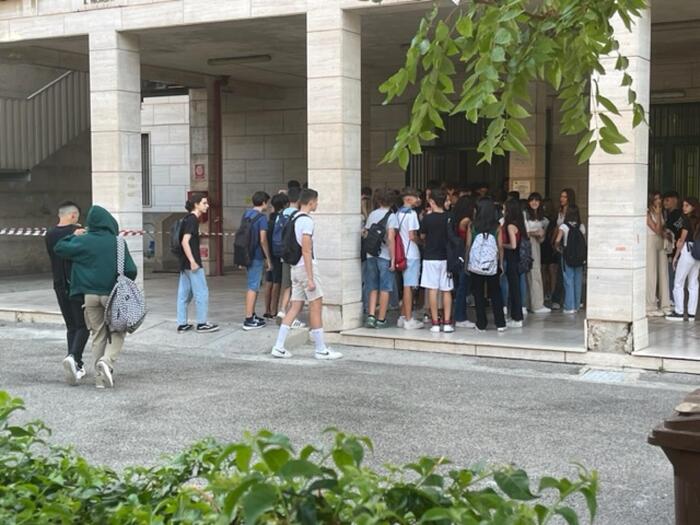ROVIGO - Fisherman of moments, hunter of emotions attentive to the composition and control of the image as for the Parisian kiss of the two lovers between the passers-by in front of the Hotel de Ville which seems to have been caught on the fly for the Life magazine and instead, he found himself alone years later, built with two extras.
There is also that mythical shot from 1950 among the 130 photographs of the exhibition that Rovigo dedicates until January 30, 2022 to Robert Doisneau to tell his tender and light way of observing the world.
His eye has focused on the lives of ordinary people, the suburbs of the capital, children, porters, bistros, the humblest jobs, the partisans and the liberation of Paris. The silver and black and white salts prints taken between the 1930s and the end of the 1950s gathered in Palazzo Roverella by Gabriel Bauret do not follow the chronological thread, but proceed by themes and come from the Atelier Robert collection. Doisneau in Montrouge where the photographer has printed and archived his images for over fifty years.
What they have in common is the author's intention to show "a world where I would feel good, where people would be kind, where I would find the tenderness I hoped to receive. My photos were like proof that this world can exist"'.
On this occasion we wanted to go beyond the cliché that Doisneau wants ironic and cheerful and ironic to show his most intimate and melancholy side. The artist, the curator points out, witnessed the difficult period of reconstruction after the First World War and did not have a happy childhood.
Exponent of French humanist photography together with Henri Cartier-Bresson, Doisneau had had his self-taught apprenticeship working for five years in the Renault workshops and had learned the importance of building the scene in 1931 in the studio of advertising photographer André Vigneau. '' The road: that's where you have to go, because you learn much more there than at school '' he used to say.
Doisneau never gets too close to faces and doesn't overload the image. The effect of freedom and lightness that his photos communicate, Bauret observes, cannot be obtained without the patience to wait even a long time before the event that 'creates' the image occurs. But Doisneau also knows how to create the illusion that scenes invented from scratch are instead the result of an unexpected encounter, not to mention by chance. The famous kiss, the curator remarks, '' has become an international icon, a symbol like the Mona Lisa, which made the author disappear a little, who let himself be eaten by his masterpiece ''.
Particularly fascinating are the shots of children playing, the cheerfulness that distinguishes them in which the author seems to have sought redemption for his 'mogie' childhood. Intense are the photos of the Liberation of Paris, with the soldiers of the Resistance posing - he too had been active there - or the throwing of leaflets in the street. There is also that, famous, of the Rest of the military (1944) by the author considered years later the best he had taken. And then there is the humorous and ironic touch as in the `` Oblique look '' (1948) of the man who peeks at the painting of a naked woman displayed on one side of a shop window while his wife is intent on commenting on the canvas in front of they. Or the Picasso, in a white shirt with dark stripes,sitting at a table on the edge of which there are two loaves that look like his big hands. '' The work often goes beyond the lightness of the situations it could represent or provoke - Bauret notes in the beautiful catalog -. Doisneau also tells the hard everyday life, shows the misery in which some of his contemporaries live and work ... which, however, does not prevent him from capturing moments of grace, like an expression of happiness that is drawn on faces and bodies ''. His is a way of proceeding freed from traditional rules that would prohibit intervening on reality. '' His motto is to disobey, always. His works are the triumph of fantasy, but also of a freedom of expression not far from surrealism ''.work often goes beyond the lightness of the situations it could represent or provoke - Bauret notes in the beautiful catalog -. Doisneau also tells the hard everyday life, shows the misery in which some of his contemporaries live and work ... which, however, does not prevent him from capturing moments of grace, like an expression of happiness that is drawn on faces and bodies ''. His is a way of proceeding freed from traditional rules that would prohibit intervening on reality. '' His motto is to disobey, always. His works are the triumph of fantasy, but also of a freedom of expression not far from surrealism ''.work often goes beyond the lightness of the situations it could represent or provoke - Bauret notes in the beautiful catalog -. Doisneau also tells the hard everyday life, shows the misery in which some of his contemporaries live and work ... which, however, does not prevent him from capturing moments of grace, like an expression of happiness that is drawn on faces and bodies ''. His is a way of proceeding freed from traditional rules that would prohibit intervening on reality. '' His motto is to disobey, always. His works are the triumph of fantasy, but also of a freedom of expression not far from surrealism ''.Doisneau also tells the hard everyday life, shows the misery in which some of his contemporaries live and work ... which, however, does not prevent him from capturing moments of grace, like an expression of happiness that is drawn on faces and bodies ''. His is a way of proceeding freed from traditional rules that would prohibit intervening on reality. '' His motto is to disobey, always. His works are the triumph of fantasy, but also of a freedom of expression not far from surrealism ''.Doisneau also tells the hard everyday life, shows the misery in which some of his contemporaries live and work ... which, however, does not prevent him from capturing moments of grace, like an expression of happiness that is drawn on faces and bodies ''. His is a way of proceeding freed from traditional rules that would prohibit intervening on reality. '' His motto is to disobey, always. His works are the triumph of fantasy, but also of a freedom of expression not far from surrealism ''.His is a way of proceeding freed from traditional rules that would prohibit intervening on reality. '' His motto is to disobey, always. His works are the triumph of fantasy, but also of a freedom of expression not far from surrealism ''.His is a way of proceeding freed from traditional rules that would prohibit intervening on reality. '' His motto is to disobey, always. His works are the triumph of fantasy, but also of a freedom of expression not far from surrealism ''.
Robert Doisneau was born in 1912 in the Parisian suburb of Gentilly. He made himself known by publishing his photos in magazines through the Rapho agency, in which he worked for almost half a century. After the Liberation, he published reportage in "Vogue" and in 1949 the book made with his friend and writer Blaise Cendrars, La Banlieue de Paris, the first of a series of works dedicated to the theme that was dear to him. He died in 1944 leaving a legacy of nearly 450,000 negatives. '' The photographs that interest me - he explained - the ones that I find successful, are the open ones, which do not tell a story to the end, but leave the viewer the opportunity to walk a piece of the road together with the image, to continue it. and finish it as you please: a kind of dream springboard ".









/cloudfront-eu-central-1.images.arcpublishing.com/prisa/NX4N5JXHQREEXKVYJJW6UJE3FU.jpg)